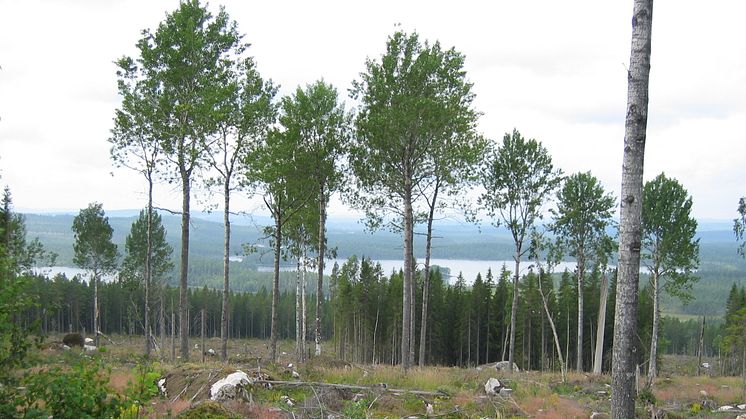
Pressmeddelande -
Retention forestry benefits biodiversity, new global meta-analysis shows
Retention forestry implies that at forest harvest some trees are left at site to promote biodiversity. Retention approaches in forestry emerged about 25 years ago as a reaction to negative ecological effects of clearcutting, and are today widely practiced on several continents, like north Europe, parts of USA, Canada and Australia. A global meta-analysis published in Journal of Applied Ecology embracing boreal and temperate regions confirms that retention forestry has good effects on forest species compared to clearcuts. Nevertheless, some forest species will still need protection of large reserves.
Many plants and animals are sensitive to clearcutting, a common forestry method in which forest is logged and replaced with temporary, open surfaces. In order to mitigate negative ecological effects, a new forestry model ’retention forestry’ emerged a few decades ago, and is now widely practiced on several continents. At retention forestry trees are left with the aim to promote biodiversity and sustain ecological functions. Despite many research studies on retention forestry and biodiversity, there still has been uncertainty on how plants and animals respond to this approach
An international research group, led by professor Lena Gustafsson and Katja Fedrowitz at SLU (Swedish University of Agricultural Sciences), Uppsala, Sweden has conducted a global meta-analysis, published in Journal of Applied Ecology, following a systematic review protocol, where data from about 80 studies have been analysed jointly.
The results are clear: forests species are promoted by retention forestry compared to clearcutting; species richness as well as abundance increase. On the other hand, mature forest is generally better for forest species than areas harvested with retention.
“Retention forestry has good effects on forest species but it is not a panacea for biodiversity. Different conservation measures need to be combined and for some forest species large set-asides, like reserves, will be a prerequisite for their long-term survival”, Lena Gustafsson says.
The researchers also analysed the effect on open-habitat species, i.e. species that occur in open areas in forest landscapes. In natural forests such open areas are created after disturbances like fires and storms. Open-habitat species had higher richness and abundance in logged areas with retained trees compared to mature forest. Retention forestry thus is positive for both forest and open-habitat species, and areas with retention also generally have higher species number compared to clearcuts as well as forest.
The amount of trees retained varies greatly between different regions and type of forest ownership. In some regions, like north Europe, levels are low, usually below 10%. It may be hard to apply results to such areas, since the average retained amount in the meta-analysis was about 30%. Still, the meta-analysis shows that the positive response on forest species increases with amount retention, and thus the more that is left, the better. Another important result was that the positive effect on forest species richness increased over time, implying that it will be essential to keep the retained trees over the long-term.
- Our overall conclusion is that retention forestry is a promising method to combine forestry and conservation, says Lena Gustafsson.
Questions may be directed to Lena Gustafsson, lena.gustafsson@slu.se, +46 70-302 27 47.
The paper can be downloaded here:
http://onlinelibrary.wiley.com/doi/10.1111/1365-2664.12289/abstract
Fedrowitz, K., Koricheva, J., Baker, S.C., Lindenmayer, D.B., Palik, B. Rosenvald, R., Beese, W., Franklin, J.F., Kouki, J., Macdonald, E., Messier, C., Sverdrup-Thygeson, A., Gustafsson, L. 2014. Can retention forestry help conserve biodiversity? A meta-analysis. Journal of Applied Ecology. DOI: 10.1111/1365-2664.12289.
|
|
Caption, photo 1: Scattered retained aspen trees (foreground) and a retention patch with spruce (background), Sweden. This type of forestry, ‘retention forestry’ aims to combine forest production and conservation. A new global meta-analysis shows that biodiversity responds positively to retention approaches at logging. (Photo: Lena Gustafsson, SLU)
Caption, photo 2: A spruce-dominated tree group retained at forest harvest to promote biodiversity, Sweden. A new global meta-analysis shows that biodiversity responds positively to retention approaches at logging. (Photo: Lena Gustafsson, SLU)
Caption, diagram: Areas harvested with the retention approach (trees left at harvest for conservation purposes) have higher richness of forest species than traditional clearcuts, and higher richness of open-habitat species than forest. Consequently, total species richness is often high on logged areas with retained trees.
Images here:
http://publish.mynewsdesk.com/se/list/images
Ämnen
Kategorier
Regioner
SLU:s vision: SLU är ett universitet i världsklass inom livs- och miljövetenskaper.


